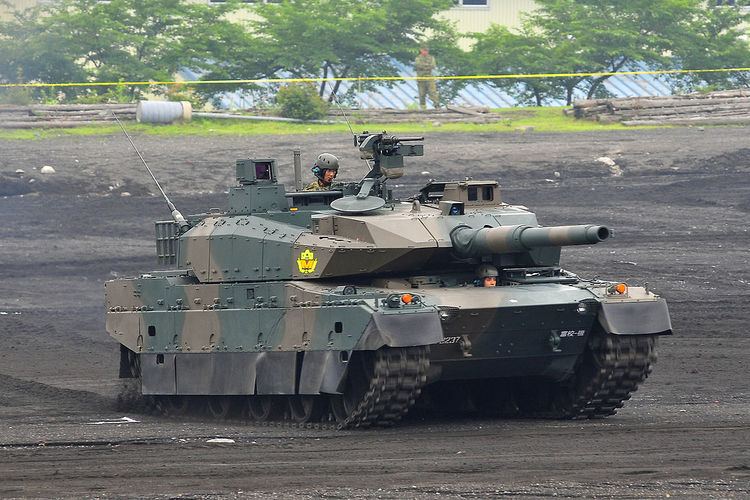In service 2012–present Produced 2010 (in production) | Place of origin Japan Unit cost $8.4 million (2014) | |
 | ||
Manufacturer | ||
The Type 10 (10式戦車, Hitomaru-shiki sensha) is a 4th generation main battle tank of JSDF produced by Mitsubishi Heavy Industries for the Japanese Ground Self Defense Force. Compared with other currently-serving main battle tanks in the JGSDF, the Type 10 has been equipped with enhancements in its capability to respond to anti-tank warfare and other contingencies.
Contents
Overview
The TK-X (MBT-X) project aims to produce the new Type 10 main battle tank, to replace or complement the existing Type 74 and Type 90 main battle tanks that are currently in service with the Japan Ground Self Defense Force. Development began in the 1990s, and production was expected to start in 2010–2011. A prototype was revealed on February 13, 2008 at the Technology Research and Development Institute (TRDI) in Sagamihara. Heavy emphasis was placed on C4I capabilities as well as on performance, firepower, protection and mobility.
Development History
In the early 2000s, Japan decided to update its tank force to better prepare for 21st Century warfare. One of the most important requirements for the new tank is the capability of having a C4I (Command, Control, Communication and Computing) system. After assessing the upgrade potential of current Type 74 and Type 90 main battle tanks, the Ministry of Defence concluded that there was not enough internal space for a C4I system upgrade on existing tanks. Therefore the development of a new main battle tank capable of various future battle missions was necessary.
Armor
The use of modular components significantly improved the side armor compared to the Type 90. The Commander's Panoramic Sight was moved to the right and is located at a higher position than the Type 90, giving the commander a wide range of view.
The vehicle's armor consists of modular sections, providing the ability to mount varying degrees of protection depending on the mission profile and weight requirements. Vehicle weight is about 40 tonnes in base configuration, and 48 tonnes when fully equipped. The prototype featured in 2008 at TRDI weighed 44 tonnes.
Armament
While the Type 10 Main Battle Tank uses the same size, caliber and type (120 mm smoothbore) gun as most other tanks fielded by NATO, unlike the Type 90 which used the same gun as other Western powers, the gun mounted on the Type 10 is completely new. It is indigenously developed by Japan Steel Works for the Type 10. Japan Steel Works (JSW) is the same company which for years now has been manufacturing the Rheinmetall L44 120 mm smoothbore gun under licence for the Type 90 MBT. There is an option for longer barrels of 50 and 55 calibers (L50, L55). The Type 10's new cannon can fire the normal JSDF developed JM33 APFSDS as well as all standard 120 mm NATO ammunition. One major improvement over the earlier Rheinmetall L44 cannon is that this new JSW gun mounted on the Type 10 tank can also fire an improved round, the newly developed: Type 10 APFSDS round. However, it should be noted that the new Type 10 APFSDS ammunition is specifically designed for and can only be fired by the Type 10's new JSW developed gun.
Electronics
The Type 10 tank is equipped with C4I system (Command, Control, Communication, Computer & Intelligence). This can be incorporated into the JGSDF network to enable sharing of information among tanks, as well as connected to the infantry's outdoor computer network "Regiment Command Control System" (ReCS) to facilitate integrated military operations with the infantry troops. Other features are as follows:
Strategic Transportation
The predecessor of Type 10, the Type 90 main battle tank, was only deployed in Hokkaido due to the weight limit of roads and bridges in other parts of Japan. One of the primary purposes of Type 10 is to be able to deploy anywhere in Japan. Size and weight reductions have made Type 10 now 6 metric tonnes lighter than Type 90, only weighing 44 tonnes. 84% of Japan's 17920 bridges are passable for the Type 10, compared to only 65% of passability of Type 90 and 40% of mainstream western main battle tanks.
Development
The development costs as of 2008 are approximately JPY ¥48,400M (approximately USD $4.47M). Each unit is expected to cost approximately ¥700M ($6.5M).
The Japanese Ministry of Defense formally acknowledged the Type 10 in December 2009. In 2010, the Japanese Ministry of Defense placed a ¥12,400M order for thirteen Type 10 tanks (Unit cost: ¥954M).
These Type 10 tanks entered JGSDF service in January, 2012.
Export
On 4 January 2014, sources revealed that Turkey was interested in signing a joint development deal of tank engines based on the Type 10's engine. The Type 10 tank boasts of high mobility, including a backward movement speed of 70 km/h (43 mph). The engine was to power the Turkish Altay indigenous tank. However, negotiations broke down and the deal was "off the agenda" by March 2014. Reasons included Japan's stringent arms export ban laws, the intention of Turkey to attempt to export the Altay, and Japan’s reluctance to license the joint engine.
